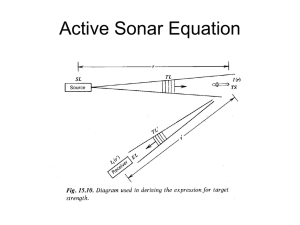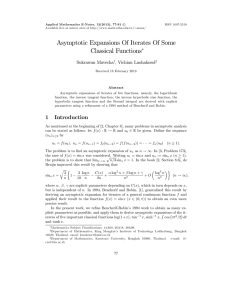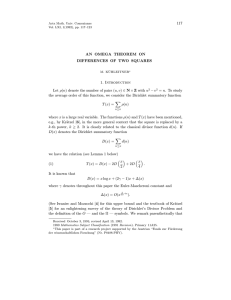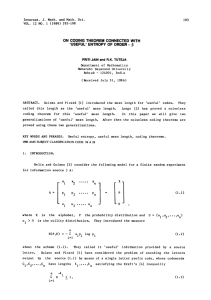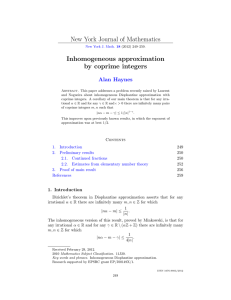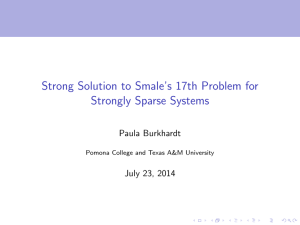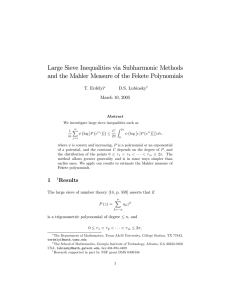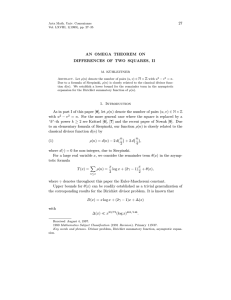ASYMPTOTIC STABILITY FOR SETS OF POLYNOMIALS
advertisement
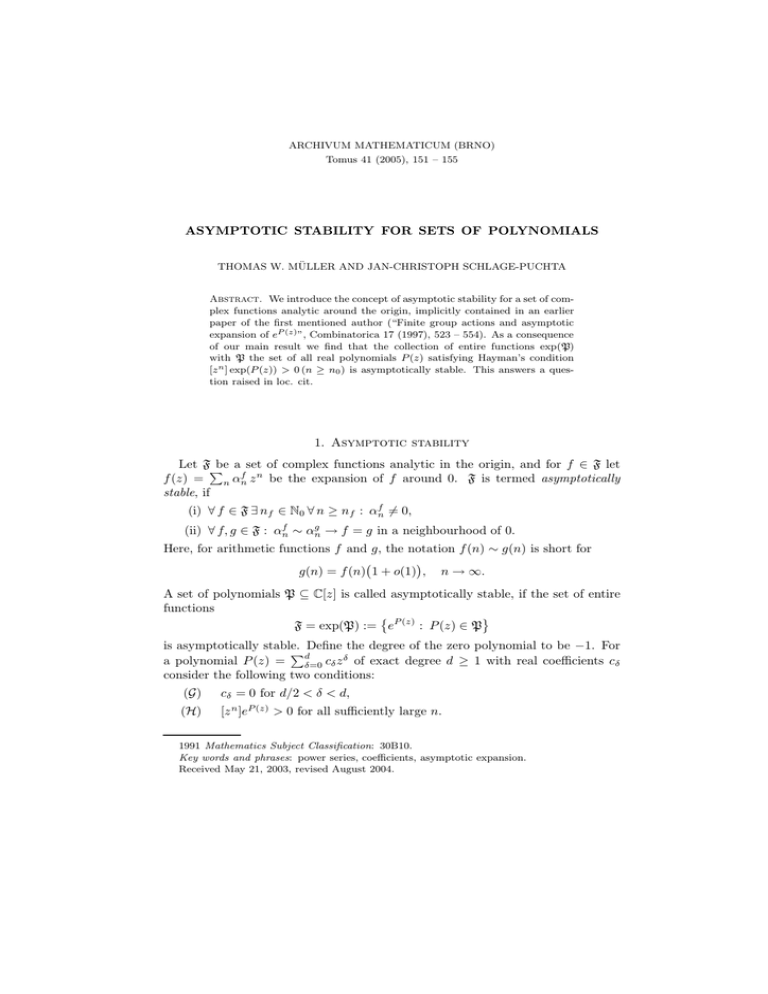
ARCHIVUM MATHEMATICUM (BRNO)
Tomus 41 (2005), 151 – 155
ASYMPTOTIC STABILITY FOR SETS OF POLYNOMIALS
THOMAS W. MÜLLER AND JAN-CHRISTOPH SCHLAGE-PUCHTA
Abstract. We introduce the concept of asymptotic stability for a set of complex functions analytic around the origin, implicitly contained in an earlier
paper of the first mentioned author (“Finite group actions and asymptotic
expansion of eP (z) ”, Combinatorica 17 (1997), 523 – 554). As a consequence
of our main result we find that the collection of entire functions exp(P)
with P the set of all real polynomials P (z) satisfying Hayman’s condition
[z n ] exp(P (z)) > 0 (n ≥ n0 ) is asymptotically stable. This answers a question raised in loc. cit.
1. Asymptotic stability
Let FP
be a set of complex functions analytic in the origin, and for f ∈ F let
f n
f (z) =
n αn z be the expansion of f around 0. F is termed asymptotically
stable, if
(i) ∀ f ∈ F ∃ nf ∈ N0 ∀ n ≥ nf : αfn 6= 0,
(ii) ∀ f, g ∈ F : αfn ∼ αgn → f = g in a neighbourhood of 0.
Here, for arithmetic functions f and g, the notation f (n) ∼ g(n) is short for
g(n) = f (n) 1 + o(1) , n → ∞.
A set of polynomials P ⊆ C[z] is called asymptotically stable, if the set of entire
functions
F = exp(P) := eP (z) : P (z) ∈ P
is asymptotically stable. Define the degree of the zero polynomial to be −1. For
Pd
a polynomial P (z) = δ=0 cδ z δ of exact degree d ≥ 1 with real coefficients cδ
consider the following two conditions:
(G)
cδ = 0 for d/2 < δ < d,
(H)
[z n ]eP (z) > 0 for all sufficiently large n.
1991 Mathematics Subject Classification: 30B10.
Key words and phrases: power series, coefficients, asymptotic expansion.
Received May 21, 2003, revised August 2004.
152
T. W. MÜLLER AND J.-C. SCHLAGE-PUCHTA
Here, [z n ]f (z) denotes the coefficient of z n in the expansion of f (z) around the
origin. Asymptotically stable sets of functions first appeared in [3], where it was
shown among other things that the set of polynomials
P0 = P (z) ∈ R[z] : P (z) satisfies (G) and (H)
is asymptotically stable. Since for a finite group G we have1
∞
X
X
zν zn
= exp
|{U : (G : U ) = ν}|
|Hom (G, Sn )|
,
n!
ν
ν
n=0
asymptotic stability of P0 implies in particular the following curious phenomenon
(“asymptotic stability” of finite groups):
If for two finite groups G and H we have |Hom(G, Sn )| ∼ |Hom(H, Sn )| as n → ∞,
then these arithmetic functions must in fact coincide.
Condition (H) arises in the work of Hayman [2], where it is shown that for a real
polynomial P (z) of degree at least 1 the function eP (z) is admissible in the complex
plane in the sense of [2, pp. 68 - 69] if and only if (H) holds; cf. [2, Theorem X].
The gap condition (G) has turned out to be an efficient way of exploiting the
fact that polynomials P (z) arising from enumerative problems very often have the
property that
supp (P (z)) ⊆ δ : δ | deg (P (z)) .
In [3] the question was raised whether condition (G) could be dropped while still
maintaining asymptotic stability, i.e., whether the larger set of polynomials
(1)
P = P (z) ∈ R[z] : P (z) satisfies (H)
is asymptotically stable. The purpose of this note is to establish the following
result, which in particular provides an affirmative answer to the latter question.
Theorem. Let P1 (z), P2 (z) ∈ R[z] satisfy Hayman’s condition (H), for i = 1, 2
(i)
let {αn }n≥0 be the coefficients of ePi(z) , and put ∆(z) := P1 (z) − P2 (z) as well
as m := max deg (P1 (z)), deg (P2 (z)) .
(i) Suppose that either 0 ≤ µ < m, or µ = m and deg (P1 (z)) = deg (P2 (z)).
(1)
(2)
Then we have deg (∆(z)) = µ if and only if | log αn − log αn | nµ/m .
(1)
(2)
(ii) If deg (P1 (z)) 6= deg (P2 (z)), then | log αn − log αn | n log n.
Here, f (n) g(n) means that f (n) and g(n) are of the same order of magnitude;
that is, there exist positive constants c1 , c2 such that c1 f (n) ≤ g(n) ≤ c2 f (n) for
all n.
Corollary. The set of polynomials P defined in (1) is asymptotically stable.
Proof. If P1 (z), P2 (z) ∈ R[z] are polynomials satisfying condition (H) as well as
(1)
(2)
(1)
(2)
αn ∼ αn , then log αn − log αn = o(1). By our theorem, deg ∆(z) 6∈ [0, m],
and hence P1 (z) = P2 (z).
1Cf. for instance [1, Prop. 1] or [4, Exercise 5.13].
ASYMPTOTIC STABILITY
153
2. Proof of the theorem
Pdi (i) δ
(i)
cδ z with cdi 6= 0. Our assumptions that P1 (z)
For i = 1, 2 put Pi (z) = δ=0
and P2 (z) have real coefficients and satisfy (H) ensure via [2, Theorem X] that the
functions exp(Pi (z)) are admissible in the complex plane; in particular, in view of
(i)
[2, formula (1.2)], we have cdi > 0. By [2, Theorem I] we find that, for i = 1, 2,
(i)
α(i)
n ∼
(i)
exp (Pi (ϑn ))
q
(i) n
(i)
ϑn
2πbi (ϑn )
(n → ∞) ,
where ϑn is the positive real root of the equation ϑPi0 (ϑ) = n, and bi (ϑ) =
(i)
(i)
ϑPi0 (ϑ) + ϑ2 Pi00 (ϑ). Since cdi > 0, the root ϑn is well defined and increasing for
1/di
(i)
n
sufficiently large n, and unbounded as n → ∞. This gives ϑn ∼
and
(i)
di cd
(i)
i
bi (ϑn ) ∼ di n, and hence
(i)
α(i)
n ∼
(2)
Formula (2) implies that
(3)
exp(Pi (ϑn ))
(i) n √
ϑn
2πdi n
(n → ∞) .
(2)
(1)
(2)
(1)
(2)
log α(1)
n − log αn = P1 (ϑn ) − P2 (ϑn ) − n log ϑn − log ϑn
1
log d1 − log d2 + o(1) .
−
2
First consider case (ii), that is, the case when d1 6= d2 . Then, by (3),
1
1
(2)
log α(1)
−
n log n + O(n) ,
n − log αn =
d2
d1
that is,
log α(1) − log α(2) n log n
n
2
n
as claimed. Next suppose that d1 = d2 . Then the right–hand side of (3) becomes
(1)
(2)
d−1
1 log(cd1 /cd2 ) n + o(n) ;
(1)
(2)
in particular, we have deg ∆(z) = m if and only if | log αn −log αn | n, which
proves the last part of (i). Thirdly, for m = 1,
(1)
(2)
(1)
(2)
(2)
log α(1)
n − log αn = c0 − c0 + n log(c1 /c1 ) + o(1) ,
(1)
(2)
in particular, deg (∆(z)) = 0 if and only if | log αn − log αn | 1. Hence, we may
assume for the remainder of the argument that m ≥ 2.
2Here, as well as in certain other places below, a more precise estimate than the one stated
is obtained, but not needed in the argument.
154
T. W. MÜLLER AND J.-C. SCHLAGE-PUCHTA
Now suppose that 0 ≤ µ := deg (∆(z)) < m. We want to show that in this case
(1)
(2)
| log αn − log αn | nµ/m . We have
0 (1)
0 (1)
0 (1)
(1)
n − ϑ(1)
n P2 (ϑn ) = ϑn P1 (ϑn ) − P2 (ϑn )
0 (1)
= ϑ(1)
n ∆ (ϑn )
µ
= aµ ϑ(1)
+ o(nµ/m ) ,
n
(4)
where a is the leading coefficient of ∆(z), which we may suppose without loss of
(1)
generality to be positive. Expanding ϑP20 (ϑ) as Taylor series around ϑn , we find
that
m−2 0
(1)
(2) 2
(1) m−1
ϑP20 (ϑ) − ϑ(1)
+O n m
ϑ − ϑ(1)
n P2 (ϑn ) = cm m ϑn
n
m−2
m 2
(5)
.
+ ϑ − ϑ(1)
+ O n m ϑ − ϑ(1)
n
n
If ϑ runs through the interval
I = ϑ(1)
n −
2aµ
2aµ
m2 c m
m2 c m
, ϑ(1)
n +
(1)
(1)
,
the right–hand side of (5) covers a range containing the interval
h
− (2 − ε)aµ ϑ(1)
n
m−1
, (2 − ε)aµ ϑ(1)
n
m−1 i
for every given ε > 0 and sufficiently large n depending on ε. Combining this
(2)
observation with (4), we find that n − ϑP20 (ϑ) changes sign in I, that is, ϑn ∈ I
(2)
(1)
(2)
for large n; in particular we have ϑn − ϑn = O(1). Since m ≥ 2, setting ϑ = ϑn
in (5) and rewriting the left-hand side via (4) now gives
(6)
aµ ϑ(1)
n
µ
m−2 2
(1) m−1
(1)
= c(1)
ϑ(2)
+O n m
+ o(nµ/m ) .
m m ϑn
n − ϑn
For x, y real, x → ∞, and x − y = O(1),
P2 (x) − P2 (y) = (x − y) P20 (x) + O (x − y) xm−2 .
Hence, applying (6), we have as n → ∞
(2)
(1)
(1)
(2)
P1 (ϑ(1)
n ) − P2 (ϑn ) = ∆(ϑn ) + P2 (ϑn ) − P2 (ϑn )
(1)
(2)
0
(1)
(1)
(2)
(1) m−2
= ∆(ϑ(1)
n ) + (ϑn − ϑn )P2 (ϑn ) + O (ϑn − ϑn )(ϑn )
µ n µ/m
=a 1−
+ o(nµ/m ) .
m m c(1)
m
ASYMPTOTIC STABILITY
155
Moreover, using (6) again,
(2)
(1)
ϑn − ϑ n (1)
log ϑ(2)
−
log
ϑ
=
log
1
+
n
n
(1)
ϑn
(2)
(1)
ϑ(2) − ϑ(1) ϑn − ϑ n
n
n
=
+
o
(1)
(1)
ϑn
ϑn
µ/m
µ−m
n
aµ −1
+ o(n m ) .
n
=
(1)
m
m cm
Inserting these estimates in (3) now yields
µ n µ/m aµ n µ/m
(2)
log α(1)
−
log
α
=
a
1
−
+
+ o(nµ/m )
n
n
(1)
m m c(1)
m
m
c
m
m
n µ/m
+ o(nµ/m ) nµ/m ,
=a
(1)
m cm
and our theorem is proven.
References
[1] Dress, A. and Müller, T., Decomposable functors and the exponential principle, Adv. in Math.
129 (1997), 188–221.
[2] Hayman, W., A generalisation of Stirling’s formula, J. Reine u. Angew. Math. 196 (1956),
67–95.
[3] Müller, T., Finite group actions and asymptotic expansion of eP (z) , Combinatorica 17 (1997),
523–554.
[4] Stanley, R. P., Enumerative Combinatorics vol. 2, Cambridge University Press, 1999.
Thomas W. Müller
School of Mathematical Sciences, Queen Mary and Westfield College
Mile End Road, London E1 4NS, England
E-mail: T.W.Muller@qmul.ac.uk
Jan-Christoph Schlage-Puchta
Mathematisches Institut, Universität Freiburg
Eckerstrasse 1, 79104 Freiburg, Germany
E-mail: jcp@mathematik.uni-freiburg.de
